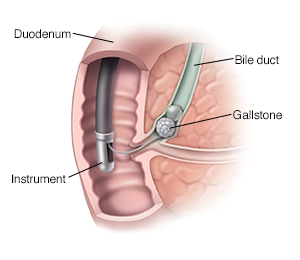Endoscopic retrograde cholangiopancreatography (ERCP) is a specialized technique used to study and treat problems of the liver, pancreas and, on occasion, the gallbladder. ERCP is performed under sedation. Generally, the level of sedation for ERCP is deeper than upper endoscopy and colonoscopy due to the complexity and length of the procedure.
To reach the small passageways, known as ducts, that connect these organs, an endoscope is passed through the mouth, beyond the stomach and into the small intestine (duodenum). The ducts from the liver and pancreas drain into the duodenum via a small opening known as the papilla. A thin tube (catheter) is then inserted through the endoscope into the papilla, thereby gaining access to the common bile duct and pancreatic duct that connect the liver and pancreas to the intestine.
A contrast material (dye) is injected through the catheter and flows into the liver and pancreas, outlining those ducts as X-rays are taken. The X-rays can show narrowing or blockages in the ducts that may be due to a cancer, gallstones or other abnormalities. During the test, a small brush or biopsy forceps can be put through the endoscope to remove cells for study under a microscope. In addition, small cylindrical tubes (stents) can be placed within the bile duct and/or pancreatic duct to treat obstructions from either benign or malignant diseases.
ERCP can be used to diagnose biliary colic, jaundice, elevated liver enzymes, cholangitis (inflammation of a bile duct), pancreatitis (inflammation of the pancreas), and bile-duct (biliary) obstruction due to gallstones (choledocholithiasis) and cancer. ERCP can be used to treat gallstones, malignant and benign biliary strictures, cholangitis, pancreatic cancer and pancreatitis. Traditionally, ERCP was used as both a diagnostic and therapeutic endoscopic tool for evaluating diseases of the bile ducts, pancreas and gallbladder. With improved Magnetic Resonance Imaging (MRI) and the emergence of endoscopic ultrasound (EUS), ERCP is now primarily a therapeutic instrument for treating conditions of the bile ducts and pancreas.
Cholangioscopy or pancreatoscopy are adjunctive procedures performed during ERCP for selected indications, in which miniature endoscopes are passed through the conventional endoscope, to enable direct visualization of the inner lining of the bile ducts and pancreatic ducts respectively. These procedures permit the endoscopist to obtain tissue specimens directly from the inner lining of the ducts and are also used to treat stones that are difficult to remove using conventional techniques.
